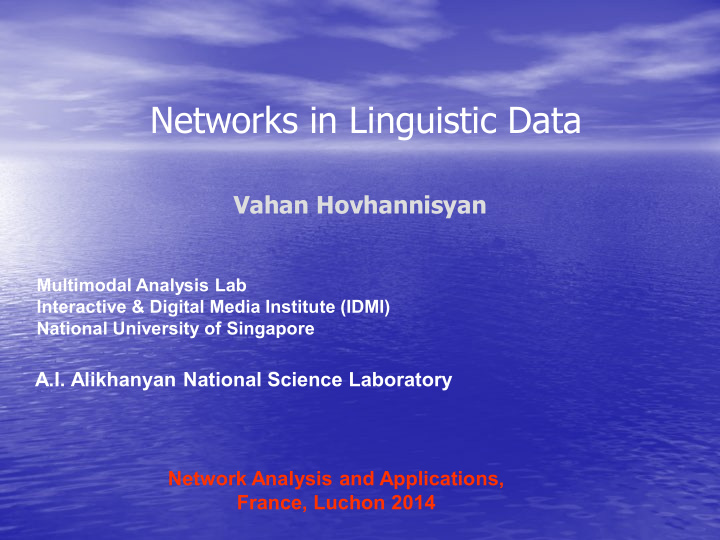



Networks in Linguistic Data Vahan Hovhannisyan Multimodal Analysis Lab Interactive & Digital Media Institute (IDMI) National University of Singapore A.I. Alikhanyan National Science Laboratory Network Analysis and Applications, France, Luchon 2014
In Systemic Functional Theory (SFT), language and other multimodal resources (i.e. visual, auditory, spatial resources) are conceptualized as inter-related semantic systems which realize three metafunctions (e.g. Halliday 1978; Halliday and Matthiessen 2004; Kress and van Leeuwen 2006; Martin 1992). The three metafunctions are concerned with • Textual meaning: to organize the message • Interpersonal meaning: to enact social relations and create a stance towards the ideas which are expressed • Experiential meaning: to construct our ideas about the world 2
Each system is consisting of sections, which can be shown schematically. Systems of Language INTERPERSONAL SECTION IDEATIONAL SECTION CLAUSE SECTION Interpersonal Metafunction Experiential Metafunction Clause Speech Function Ergativity Mood Voice TEXTUAL SECTION Mood Congruence Textual Metafunction Modality Theme Count Modality Orientation Topic Theme Type Mood Adjunct Type Tense Polarity Systems of Image INTERPERSONAL SECTION IDEATIONAL SECTION Gaze and Kinetic Action Vectors Conceptual Representation Interactive Meaning Systems of Sound SOUND SECTION 3 Sound
Time-Stamped SFT Multimodal Data Base 4
Time-Stamped SFT Multimodal Data Base Textual Metafunction 5
6
7
Interviewer Jon Scott favors simple forms of textual organization (Cluster 4) which enables him to quickly focus on issues of concern, while Dr Trenberth frequently uses conjunctions like ‘and’ and ‘but’ to elaborate and explain on the points he is trying to make (Cluster 6). Mr Ebell uses a wide range of textual resources, including conversational continuatives which result in many cluster pairings (e.g. Cluster 3-6, Cluster 4-6 and Cluster 4 -5 and repetition of simple forms of thematic organization (Cluster 4). Mr Ebell’s use of simplified forms of repetition have the effect of reinforcing his arguments which are delivered in a conversational style, compared to Dr Trenberth’s uneven attempts to logically connect the events which are under discussion during the interview. 8
Interpersonal Metafunction: Jon Scott Interpersonal Metafunction: Mr Myron Ebell 9 Interpersonal Metafunction: Dr Kevin Trenberth
THANK YOU!!! 10
Recommend
More recommend